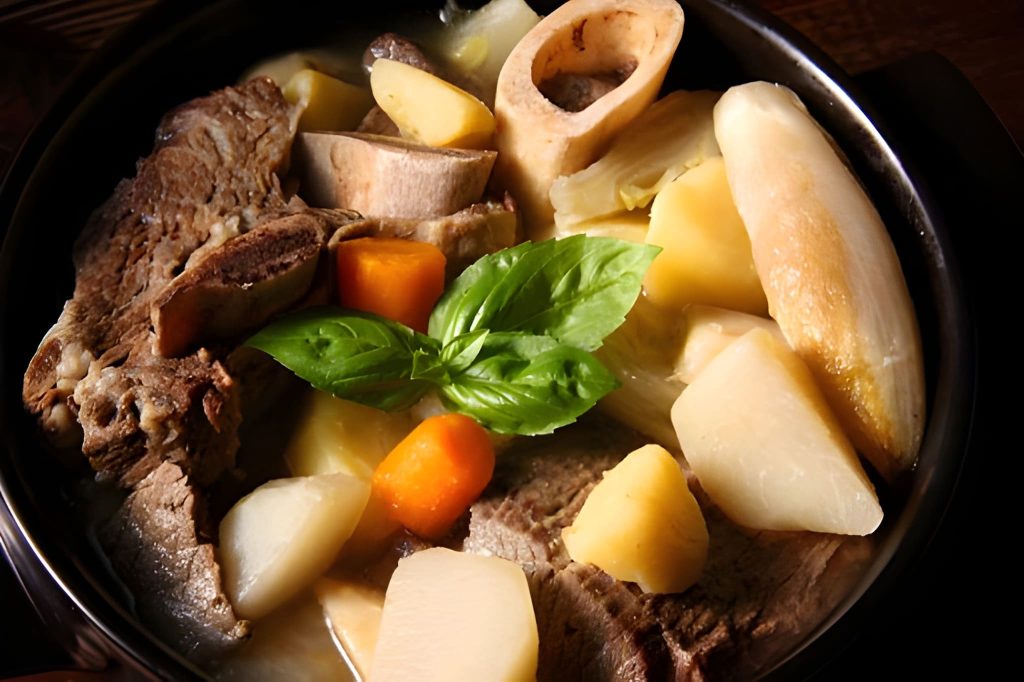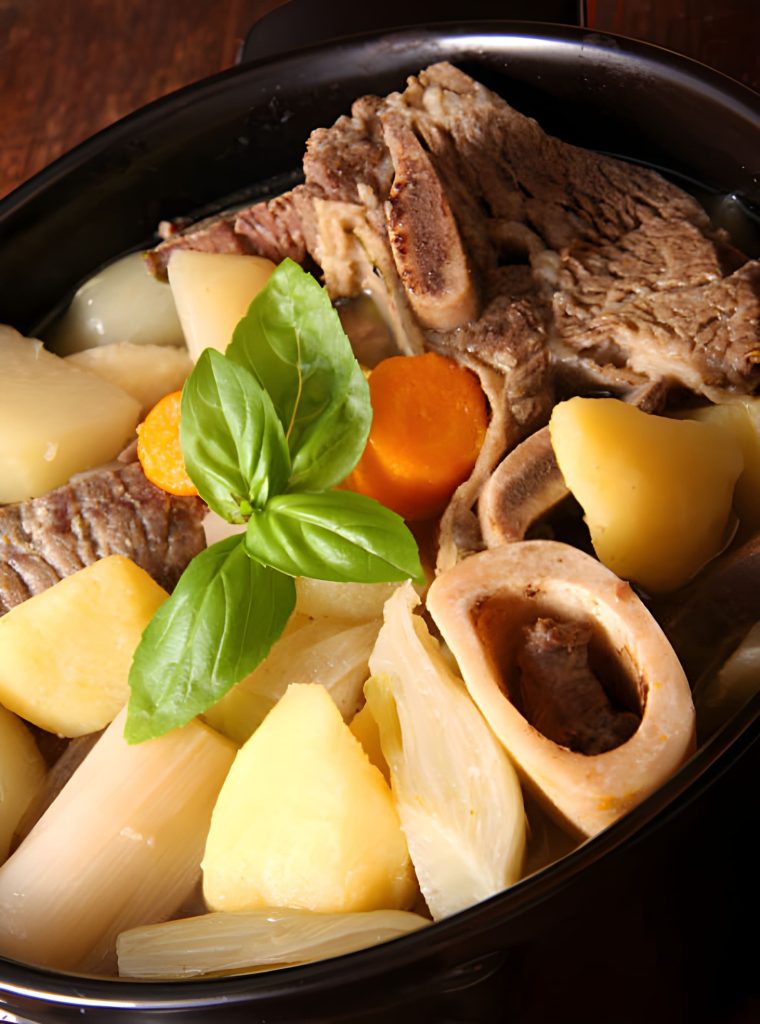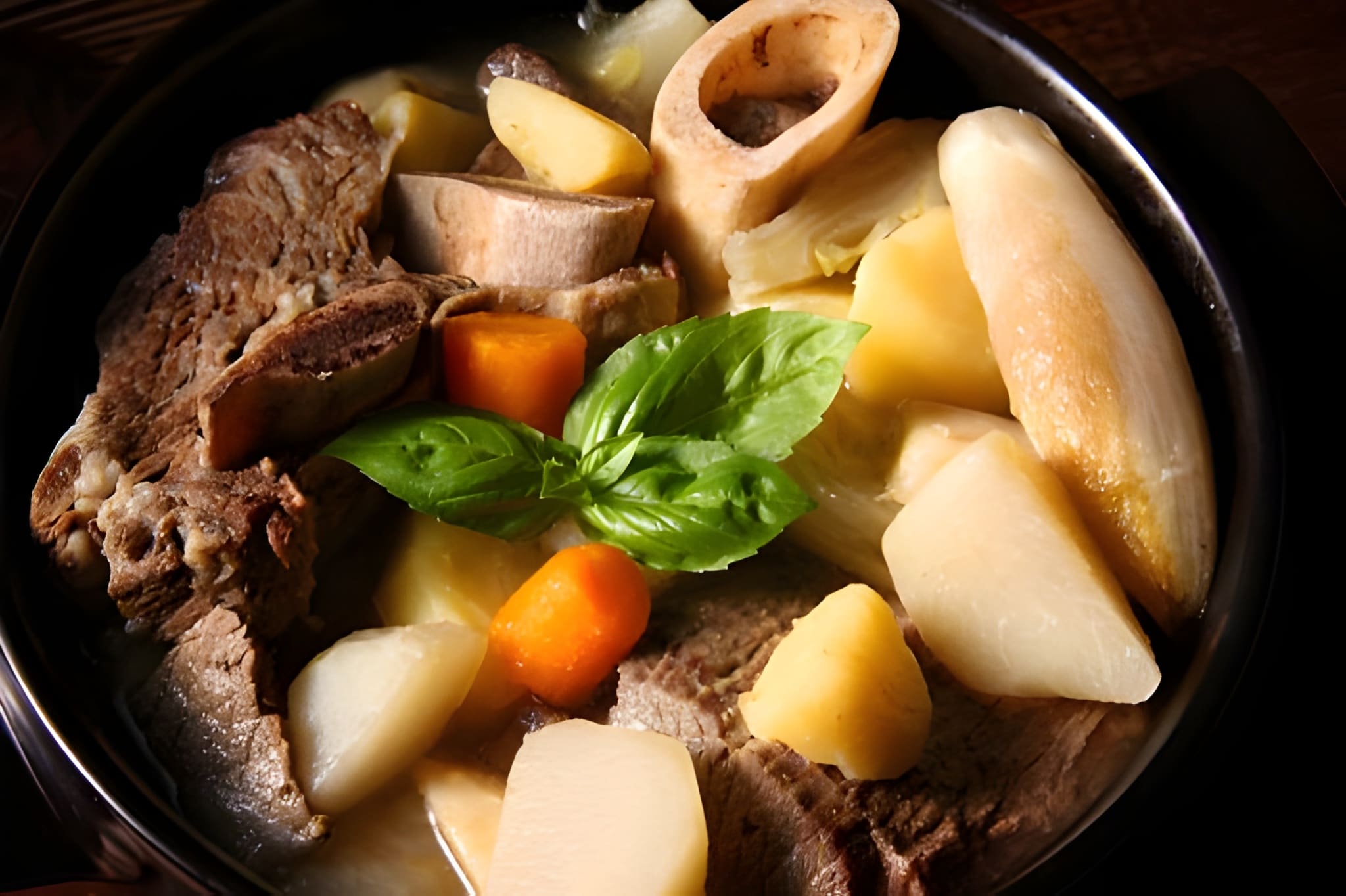Pot au Feu Recipe
Few dishes capture the soul of French comfort food quite like Pot au Feu. This slow-simmered masterpiece unites tender cuts of beef, a crystal-clear marrow-rich broth, and a vibrant collection of root vegetables. Every element contributes to a dish that is both rustic and elegant, brimming with deep flavors that only hours of patient cooking can achieve. The gentle aroma of simmering herbs, beef, and vegetables fills the kitchen, evoking a sense of warmth and tradition that makes it perfect for family gatherings or refined dinner occasions.

Ingredient Breakdown
The beauty of Pot au Feu lies in its simplicity — high-quality ingredients brought together through slow, deliberate cooking. The beef shanks lend their robust flavor and gelatinous texture, while the rump roast or bottom round adds meaty depth and tenderness to the broth. These cuts, when simmered patiently, yield both rich stock and melt-in-your-mouth meat.
Root vegetables play an equally vital role, creating harmony and balance in the stew. Carrots and parsnips bring natural sweetness, turnips and rutabagas add earthy undertones, while potatoes absorb the savory broth, becoming buttery and tender. Leeks, celery, and onions provide the aromatic backbone that transforms the broth from simple to sublime.
Herbs such as thyme, parsley, and bay leaves infuse the liquid with subtle fragrance, complemented by whole peppercorns and kosher salt that season the dish gently as it cooks. Marrow bones, though optional, add an incomparable richness and silkiness to the broth, elevating its texture and flavor. When served, traditional accompaniments like horseradish, coarse mustard, and sour cream enhance the meal’s final dimension, offering creamy and tangy contrasts to the hearty stew.
Step-by-Step Preparation Guide
Crafting Pot au Feu begins by layering flavors from the ground up. The process starts with arranging onions, leeks, celery, and carrots at the base of a heavy pot to create an aromatic bed. The beef shanks and tied rump roast rest above these vegetables, slowly releasing their essence as they cook. The bouquet garni — a simple bundle of parsley, thyme, and bay leaves — ties everything together, adding delicate herbal notes that infuse the broth.
As the pot reaches a gentle simmer, it’s essential to maintain a steady, low heat. This ensures the beef cooks slowly, keeping it tender while preventing the broth from becoming cloudy. Skimming away impurities that rise to the surface is a small yet crucial step for clarity and finesse. Over the course of two and a half hours, the liquid transforms into a deeply aromatic broth, while the beef absorbs every layer of flavor.
Once the meats are tender, the broth is strained to remove the spent vegetables and herbs, leaving behind a golden, savory liquid. Returning the broth to the heat, it’s reduced until concentrated, its flavor intensified and balanced. Then comes the vibrant stage of cooking the vegetables — fresh carrots, celery, leeks, and the medley of parsnips, turnips, and rutabagas are gently simmered until just tender. Potatoes and marrow bones are added toward the end, ensuring they cook perfectly without falling apart.
Finally, the meats are sliced and returned to the pot to reheat briefly before serving. Each component — meat, vegetable, and broth — harmonizes beautifully in both flavor and texture, offering comfort in every spoonful.

Recipe Tips
The best beef cuts to use for flavor and tenderness:
Opt for a mix of marrow-rich and lean cuts like shanks and rump roast for depth and texture.
How to avoid a cloudy broth when simmering:
Keep the simmer gentle and avoid rapid boiling, skimming the surface often for impurities.
Adjusting seasoning for balanced taste:
Taste near the end of cooking and season lightly with salt and pepper to highlight natural flavors.
Tricks for reheating or storing leftovers without losing quality:
Cool completely before refrigerating; reheat gently to preserve the broth’s clarity and the vegetables’ tenderness.
What to Serve With This Recipe
Pot au Feu shines when accompanied by simple, complementary sides that allow its flavors to stand out. A warm, crusty baguette or slices of rustic country bread are perfect for soaking up the golden broth. A light green salad with a mustard vinaigrette offers a crisp counterpoint to the stew’s richness, while roasted root vegetables or buttered haricots verts add color and texture to the table.
For those who enjoy wine pairings, a medium-bodied red such as a Bordeaux or Côtes du Rhône beautifully complements the beef and the earthy undertones of the vegetables. Alternatively, a chilled glass of dry white wine like Chablis can provide a refreshing balance to the dish’s savory warmth.
Frequently Asked Questions
Can I make Pot au Feu in advance?
Yes. In fact, the flavors deepen beautifully overnight. Chill and skim any fat before gently reheating.
How can I substitute cuts of beef if some are unavailable?
Brisket, short ribs, or chuck can be excellent alternatives to rump roast.
Do I need to use marrow bones?
They are optional but highly recommended for richness and silkiness.
What’s the best way to clarify the broth?
Strain it through a fine sieve or cheesecloth, and avoid stirring during simmering to keep it clear.
How long can leftovers be stored and reheated?
Store in the refrigerator for up to 3 days or freeze for up to 3 months. Reheat slowly over low heat.
Creative Variations
Pot au Feu invites creativity and adaptation throughout the year. For a lighter version, substitute chicken or veal for the beef, adjusting cooking time accordingly. Seasonal vegetables such as fennel, cabbage, or turnip greens can be swapped in during spring and summer months for a fresher twist. Leftovers can transform effortlessly into new dishes — shredded beef and vegetables make an excellent filling for sandwiches, or the broth can be repurposed as a rich soup base the next day.
Pot au Feu is more than a traditional French recipe — it’s a reflection of patience, simplicity, and culinary grace. With every simmering hour, it becomes richer, more flavorful, and deeply satisfying. Whether shared around a lively dinner table or enjoyed quietly on a cold evening, this timeless dish reminds us that the finest meals often come from humble ingredients treated with care and love.

Ingredients
4 meaty beef shanks (about 3 pounds), sliced 1 ½ inches thick
1 (3-pound) beef rump roast or bottom round, securely tied
8 to 10 marrow bones, about 2 inches each (optional)
1 large onion, quartered
6 medium carrots, peeled and halved crosswise, divided
6 large leeks, white and light green parts only, trimmed and cut into 2 ½-inch sections, divided
12 celery ribs, halved crosswise, divided
6 medium parsnips, peeled and cut into 2-inch pieces
6 medium turnips, peeled and quartered
1 pound rutabagas, peeled and cut into eighths
1 ½ pounds small unpeeled potatoes, scrubbed clean
4 sprigs fresh parsley
4 sprigs fresh thyme
2 bay leaves
1 teaspoon whole black peppercorns
1 tablespoon kosher salt, plus more to taste
8 quarts water
Freshly ground black pepper, for seasoning
Horseradish or whole grain mustard, for serving
Sour cream, for serving
Instructions
Place the quartered onion in a large, heavy-bottomed stockpot along with half of the leeks, celery, and carrots. Arrange the beef shanks and tied rump roast over the bed of vegetables. Gather the parsley, thyme, and bay leaves into a bundle using a small square of damp cheesecloth and tie it securely with kitchen twine. Drop the herb sachet into the pot along with the peppercorns and kosher salt. Add two marrow bones if using, then pour in the 8 quarts of water to fully submerge the ingredients.
Bring the mixture to a steady boil over high heat. Once boiling, reduce the heat to low and partially cover the pot. Allow the broth to simmer gently for about 2 ½ hours, skimming off any foam or impurities that rise to the surface. The meat should be fork-tender and richly infused with the flavors of the aromatics.
Carefully remove the beef shanks and rump roast and transfer them to a large bowl. Cover to keep warm. Strain the broth through a fine sieve, discarding the spent vegetables and herbs. Return the clear broth to the pot and bring it to a boil over high heat. Continue boiling until reduced to about 10 cups, skimming off excess fat as needed—this will take roughly 45 minutes.
Add the remaining carrots, leeks, and celery to the clarified broth, followed by the parsnips, turnips, and rutabagas. Cover and simmer over low heat for 30 minutes, or until the vegetables begin to soften. Add the remaining marrow bones and the scrubbed potatoes, cover again, and continue cooking for another 40 minutes until the potatoes are tender all the way through.
Remove the string from the rump roast and slice it against the grain into 6 to 8 portions. Cut the shank meat into hearty 2-inch chunks. Return the meats to the pot and let them warm through in the fragrant broth for a few minutes. Season the mixture generously with salt and freshly ground black pepper to taste.
To serve, ladle the hot broth into wide, shallow bowls. Add slices of meat, marrow bones, and tender vegetables to each bowl. Serve immediately, offering horseradish, coarse mustard, and sour cream on the side for guests to mix as they please.

Pot au Feu Recipe
Ingredients
- 4 meaty beef shanks about 3 pounds, sliced 1 ½ inches thick
- 1 3-pound beef rump roast or bottom round, securely tied
- 8 to 10 marrow bones about 2 inches each (optional)
- 1 large onion quartered
- 6 medium carrots peeled and halved crosswise, divided
- 6 large leeks white and light green parts only, trimmed and cut into 2 ½-inch sections, divided
- 12 celery ribs halved crosswise, divided
- 6 medium parsnips peeled and cut into 2-inch pieces
- 6 medium turnips peeled and quartered
- 1 pound rutabagas peeled and cut into eighths
- 1 ½ pounds small unpeeled potatoes scrubbed clean
- 4 sprigs fresh parsley
- 4 sprigs fresh thyme
- 2 bay leaves
- 1 teaspoon whole black peppercorns
- 1 tablespoon kosher salt plus more to taste
- 8 quarts water
- Freshly ground black pepper for seasoning
- Horseradish or whole grain mustard for serving
- Sour cream for serving
Instructions
- Place the quartered onion in a large, heavy-bottomed stockpot along with half of the leeks, celery, and carrots. Arrange the beef shanks and tied rump roast over the bed of vegetables. Gather the parsley, thyme, and bay leaves into a bundle using a small square of damp cheesecloth and tie it securely with kitchen twine. Drop the herb sachet into the pot along with the peppercorns and kosher salt. Add two marrow bones if using, then pour in the 8 quarts of water to fully submerge the ingredients.
- Bring the mixture to a steady boil over high heat. Once boiling, reduce the heat to low and partially cover the pot. Allow the broth to simmer gently for about 2 ½ hours, skimming off any foam or impurities that rise to the surface. The meat should be fork-tender and richly infused with the flavors of the aromatics.
- Carefully remove the beef shanks and rump roast and transfer them to a large bowl. Cover to keep warm. Strain the broth through a fine sieve, discarding the spent vegetables and herbs. Return the clear broth to the pot and bring it to a boil over high heat. Continue boiling until reduced to about 10 cups, skimming off excess fat as needed—this will take roughly 45 minutes.
- Add the remaining carrots, leeks, and celery to the clarified broth, followed by the parsnips, turnips, and rutabagas. Cover and simmer over low heat for 30 minutes, or until the vegetables begin to soften. Add the remaining marrow bones and the scrubbed potatoes, cover again, and continue cooking for another 40 minutes until the potatoes are tender all the way through.
- Remove the string from the rump roast and slice it against the grain into 6 to 8 portions. Cut the shank meat into hearty 2-inch chunks. Return the meats to the pot and let them warm through in the fragrant broth for a few minutes. Season the mixture generously with salt and freshly ground black pepper to taste.
- To serve, ladle the hot broth into wide, shallow bowls. Add slices of meat, marrow bones, and tender vegetables to each bowl. Serve immediately, offering horseradish, coarse mustard, and sour cream on the side for guests to mix as they please.

